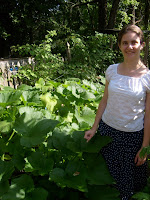With the gardening season coming in full bloom; also, comes pest control. The biggest thing with pest control is identifying the pests. Here are a few things I have tried or am going to try. First, with any battle on bugs just like with weeds, the key is to start early. There are homemade formulas, barriers, and traps. One such trap that I have used is a sticky trap. I have spray painted circles of red plastic (apple shapes) and coated them with sticky glue(that does not dry out) and hung them in my fruit trees. Another idea is to spray paint soup cans with bright red and yellow paint and coat them with Vaseline. I then turn them upside down and set them on plant stakes or on the fence around the garden. I have used milk spores effectively to get rid of the Japanese beetle population around my area. There is also diatomaceous earth that scratches the soft body of snails and slugs and other pests. Crushed up egg shells can do the same thing and they will add calcium to the soil. You may like to put cardboard collars around your plants to keep cutworms from chewing through them. Here is a common list floating around the internet on homemade pesticides.
Soap Spray:
Another way to stop the slugs is with soapy water. That's right, you can just use your old, dirty dishwater! Collect some of the water in a pan and pour it into a watering can or even use a pitcher to pour it over the plants. This works really well on hostas and mums, but also can be used on other hardy plants. Many bugs do not like their lunch spoiled by a soapy aftertaste! For a stronger solution, mix 3 Tablespoons of liquid detergent into a gallon of water, I prefer Dawn, but any will do. Use this weekly.
Alcohol Spray: This spray really is great for houseplants. This especially works on meal bugs.
1/2 cup of rubbing alcohol
2-3 tablespoons of dry laundry soap
1 quart of warm water
Mix all ingredients and spray immediately. You don't have to let this set, but you can't store it either. This solution must be made fresh for each use.
Salt Spray: This solution is used for cabbageworms and spider mites.
2 tablespoons of salt
1 gallon of water
Just mix and spray!
Garlic Spray:
Here is the recipe for a garlic spray that fights slugs too. Slugs must not like eating Italian. To make this smelly spray, use the following list of ingredients:
1 garlic bulb
1 quart of water
1 medium onion
1 tablespoon of cayenne pepper
1 tablespoon liquid dish soap
Crush the garlic, mincing it fine. Add finely chopped onion to the mixture, while adding the rest of the ingredients except the soap. Wait an hour before adding the soap to the mixture. The spicy ingredients must sort of stew or steep, almost like tea. After an hour, add the soap and your non-toxic spray is ready to use! This can be stored in the fridge for a week.
Dead Bug Spray:
Another way to beat the bug problem is by taking some dead carcasses of the same insects and mixing them in water. Use one pint of water and 1/2 cup of slug carcasses. Although this is rather unpleasant, it works.
Blend the water and insects until mixed well and then put into a plastic container or glass jar. To use this, strain and then pour it into a sprayer and squirt a few drops on the affected plants. You can freeze this mixture for storage.
*Beware: Do NOT use flies, ticks, fleas, or mosquitoes in this solution! These insects carry many communicable human diseases!
Spearmint-Hot Pepper-Horseradish Spray: This works on many different kinds of bugs- too many to list!
1/2 cup of red peppers (hot)
water (read below)
1/2 cup of fresh spearmint
1/2 cup horseradish (root and leaves)
2 tablespoons of liquid detergent
1/2 cup green onion tops
Mix all of the spearmint leaves, horseradish, onion tops and peppers together with enough water to cover everything. Strain the solution. After mixing all of these, add a half-gallon of water and add the detergent also. To use this solution, mix 1/2 gallon of this solution with 1/2 gallon of water. You can use this to spray almost any plant safely. Store this mixture for a few days in a cool environment.
These are just a few of the most common recipes to kill pests. Buying beneficial insect like ladybug or planting certain types of plants that attract them.
Try some and let me know which you have tried and like the best.



























